
ASM Terni
ID: 4420
July 18, 2022
Smart metering enables energy management and flexibility in Smart Grids.
ID: 4633
November 25, 2022
Veoneer is a worldwide leader in automotive technology. The company designs, develops and manufactures technology systems for active safety and restraint control that facilitate advanced driving assistance and automated driving.
The Veoneer headquarter is located in Stockholm, Sweden, and the company has a force of 7,500 people working across 11 countries in 19 technical centres and six manufacturing sites. The workforce is a combination of automotive safety expertise and technical competence working together with the purpose to create trust in mobility and with the mission to save lives in traffic.
Veoneer was founded in 2018, as a spin-off from Autoliv, after having designed, manufactured and delivered electronic safety products for two decades. The present focus of Veoneer is on developing human-centric innovations to provide automotive applications that bring safety and convenience to the consumer and society. The company do so by deploying cutting-edge technology systems in vehicles to prevent traffic incidents from happening and mitigate the effect when accidents are unavoidable.
All hardware for the systems is produced in-house (e.g., sensors for radar, LiDAR, thermal and vision sensing, electronic controls and human-machine interfaces), and Veoneer also does the integration that relies on dedicated software development for the applications to be functional in the vehicle. The complete systems and solitary applications are offered to vehicle manufacturers globally – over the last decade counting 8.2 million cameras, 42 million radars and 890 million electric control units and crash sensors.

Staying at the forefront of technologies is a prerequisite for Veoneer to support its customers in launching the safest possible vehicles, and artificial intelligence (AI) and deep learning are a natural part of the development process. With the use case of collective perception, the leading auto-tech company aims to increase processing efficiency across entities in the traffic ecosystem. This increase shall be achieved through the distribution of the processing tasks (over the entities, to the edge, to the cloud) in order to join and process the information with low latency, ensuring safe and stable communication.
“We call this collective perception. So we collect a lot of data from different sources. All of this data is dynamic, so the timeliness – the latency – of the information is very important.”
Olof Eriksson, Research Specialist at Veoneer
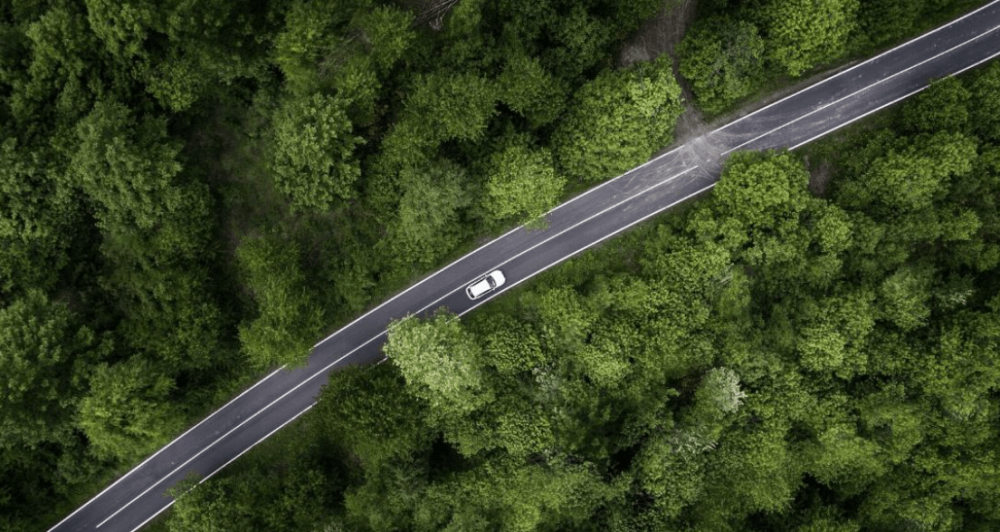
The incentive of Veoneer to develop IoT, in terms of a Collective Perception Solution for vehicles, derives from a desire to contribute to the shift towards the mobility of the future: safe, convenient and low environmental impact. To achieve this, Veoneer is focussing on the sensing system of transport vehicles, looking to increase the capability of the system to interact and integrate with the ambient infrastructural environment.
“Sensors in vehicles can be considered as IoT devices, but we are also using a lot of other information sources. This is exactly what IoT is: the collection of data from multiple sources.”
Olof Eriksson, Research Specialist at Veoneer
According to the WHO, almost 1.4 million lives are lost on roads globally each year. Veoneer works to increase safety in traffic and lessen the woeful statistics by developing vehicular systems that prevent traffic accidents or, when accidents are unavoidable, help mitigate the effects of a crash. The company aims to democratise safety through a scalable system architecture where the same base technology platform can be used from basic driver assistance solutions up to fully autonomous driving. However, as the level of autonomy increases, so does the complexity of technology and the amount of information needed to accordingly increase vehicular intelligence. Veoneer’s technology systems provide full access, capacity and capability to process and utilise the data generated by a vehicle’s sensing system and operating system. However, this data entails information only on that single vehicle as an isolated entity.
“How to put this together and actually create some sort of useful output of these sensors? Of the single processing of the data?”
Olof Eriksson, Research Specialist at Veoneer
In the age of automated driving, vehicles cannot be considered isolated entities. Rather, they are part of a traffic ecosystem that numerous entities and billions of IoT devices are part of as well – and all these entities need to interact. They need collective perception meaning that information generated by single entities needs to be joined and that the interactions between entities must be secure, auditable, sharable, dynamic and transferable without delay. Such collective perception would enable vehicles to constantly have information about the next few seconds of future traffic happenings available.
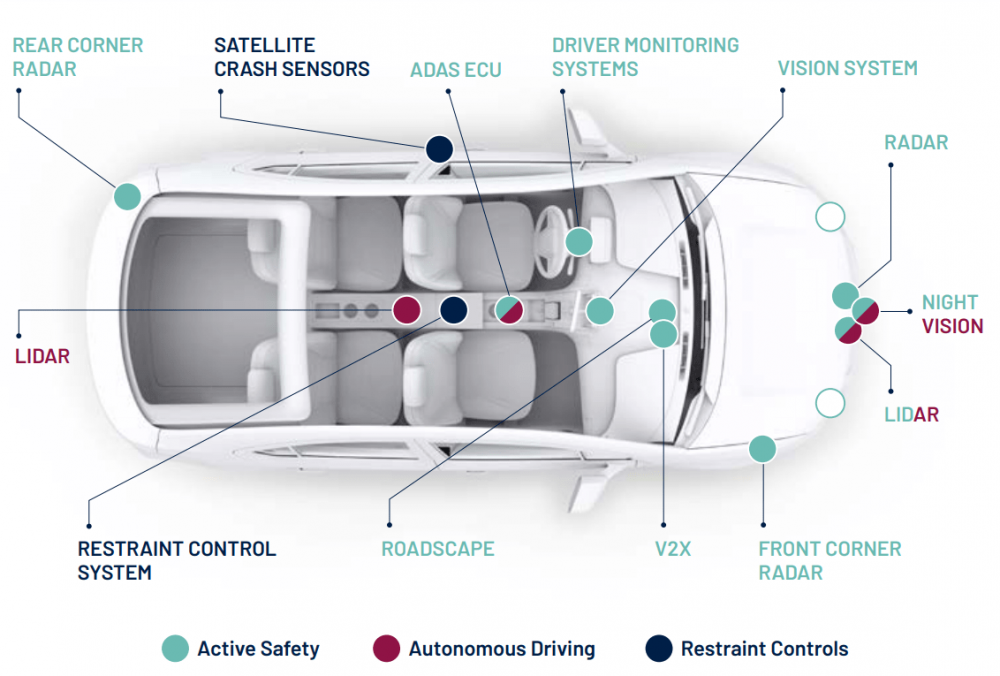
In order to join the information generated by all entities of the traffic ecosystem, each entity would basically have to operate as an IoT device, being able to collect data and connect to the internet in order to share it with other entities. Hence, the relevant data generated by vehicles needs to be made accessible outside the single vehicle – it needs to be made openly available – and therefore transferred to the cloud for storage and sharing. However, for a database to join data from billions of devices, and process that data into information of relevance for each and all of the single entities, computation power beyond belief would be necessary to ensure sufficient performance and security of the data communication.
“The problem today is that actually, the communication is not stable enough. It is not safe enough.”
Olof Eriksson, Research Specialist at Veoneer
Computation power is a notorious challenge of the present that poses a central barrier to the further progress of autonomous driving. Based on this challenge, and the vast potential it brings to the AD area if resolved, as well as discussions with users, vehicle manufacturers, external partners, network providers and academia, Veoneer is dedicated and determined to explore a solution for enabling vehicular collective perception in the traffic ecosystem.
For the proposed solution, Veoneer is using Distributed Ledger Technology (DLT) to build a platform for collective perception that supports efficient and secure transaction and recording of information between devices, and that can be accessed and processed by entities at each node of the network.
In late 2020, the company joined forces with the VEDLIoT project to enable fast deployment and testing of the proposed solution as well as to collaborate with experts in the area.

Veoneer’s Collective Perception Solution is based on information from multiple entities and devices to enable vehicular autonomy – whereas the ones that Veoneer deliver and control are those inside the vehicle. These devices constitute the vehicular sensing system, which manages transitions between normal operation and risk scenarios in the surrounding traffic and makes real-time decisions and actuation that enable complete or partly automation.
“It is still IoT, but it is aiming at much higher data rates, and the amount of data in the end that we will need to process will be much larger.”
Olof Eriksson, Research Specialist at Veoneer
Physical devices inside the vehicle include a variety of sensors that, based on electromagnetic radiation, perceive positioning through vision, radar and LIDAR, and the integrated vehicular systems that perceive the longitudinal and lateral control (for example acceleration, brake pressure, angle of the steering wheel etc.).
The sensor data and control signals are transmitted to the Electronic Control Unit (ECU) of the vehicle that performs some basic processing of the raw data. This decentralised processing enables the vehicular sensing system to apply deep learning algorithms to the data. Deep learning, a branch of machine learning, uses convolutional neural network technology for free space and small obstacle detection to manoeuvre the vehicle safely by:
For the single vehicle to become an integrated part of traffic, it needs to interact with the other entities of the traffic ecosystem and process that information as well. However, the vehicle’s ECU has limited processing capacity due to the large amount of power required for connecting with other entities and for facilitating communication latency and stability (hence, in electrical cars an ECU capacity increase would suck power from the vehicle, and in petrol cars, it would cause significant fuel costs). Nevertheless, for the data to be useful, it needs to be sharable and processed further and therefore it needs to rely on other units to supply connection and processing capacity; this could be edge computers of shared servers or dedicated servers owned by, for example, a data centre or the car manufacturer. To access the server, the ECU connects (via 5G or, if available, Wi-Fi) to a cellular base station in near proximity, which enables the data transmission to the cloud.
Much like the vehicle, other entities in the traffic ecosystem generate data on location, activity and perception decentralised. The dynamic data from each isolated entity (e.g., a traffic light, an infrastructure camera, a temperature measurement, a navigation application, an infrastructure record etc.) is likewise transmitted to the cloud, which becomes one massive database that joins all data of the entire traffic ecosystem. DLT generates a ledger of the collective data, which is accessible across locations and entities at each node of the network.
“We are collecting data from multiple sources, meaning different sensors – or things – around the world. So it is not just from vehicles.”
Olof Eriksson, Research Specialist at Veoneer
The joined traffic data is processed in the cloud with Veoneer’s software platform, translating it into information to achieve collective perception. This information is transmitted back to the vehicle’s ECU which performs the final processing for providing the collective perception that enables vehicular autonomy.
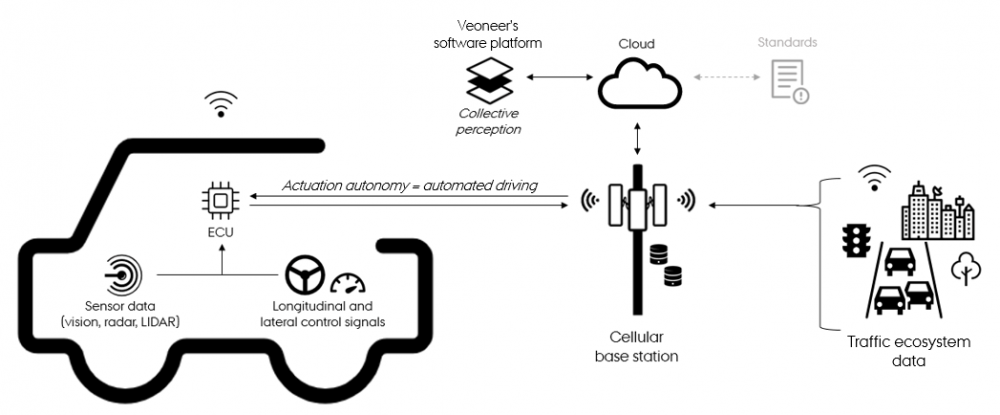
Hence, the joining of traffic data and distributed processing of it serves as a solution for establishing the collective perception – the intelligence – of the vehicle. The essential capability of this solution is to generate real-time trajectory information in correlation with other traffic entities that enables the timely activation of decision-making and actuation software, which control acceleration, positioning and braking; all essential means for a vehicle to communicate with the ambient infrastructural environment as well as driver and passengers.
Veoneer’s hardware and software stacks are automotive-grade systems for active safety and restraint control that are designed to meet the requirements of vehicle manufacturers and regulators globally. Automation features that are currently available in these systems include autonomous emergency braking, adaptive cruise control, lane keep assist, lane departure warning and traffic sign recognition. More advanced features with higher levels of autonomy are developed already, and commercialisation is foreseen with the accomplishing of vehicular collective perception.
The systems developed by Veoneer blend the best of human and machine intelligence into a sophisticated driving system where the human driver is still interacting with the intelligent technology. High-performance driver state analysis is used to monitor levels of attention, distraction, drowsiness, engagement and impairment with warning and intervention strategies developed using human factors and behavioural research to keep the human driver in the loop, regardless of the level of vehicular autonomy.

Using DLT in the solution can ensure that the needed information from the traffic ecosystem is synchronized and accessible across different sites, geographies and devices by the multiple entities and that any changes or additions made to the ledger are reflected and copied to all entities in a matter of seconds. However, DLT is not a standard application in the industry. The many vehicles and other entities in the traffic ecosystem originate from many different sources, are manufactured by many different corporations and have many different existential purposes – and therefore, widespread standards are needed to support them in communicating and in leveraging the value of collective information sharing. Hence, for Veoneer’s Collective Perception Solution to reach its full potential, industry standards must be commonly agreed upon among the entities of the traffic ecosystem.
The common reason behind the reluctance to partake in standardisation is the fear that competitive advantages may be renounced when information is shared. Veoneer does acknowledge that industry competition is a motivator for accelerating business performance and advancing core capabilities, but finds that competitive advantages should lie, not in the information itself, but in how the information is used.
“When I get the information and create this perception of what is around me – how do I use that information? THAT is the trade secret!”
Olof Eriksson, Research Specialist at Veoneer
The safety promise of self-driving vehicles is that they will save hundreds of thousands of lives, and greater transportation efficiencies will reduce pollution and improve the time we spend travelling. But that future is at least a decade away – and during this time we will rely on advanced and improved ADAS.
Vehicles today are complex systems on wheels comprising a variety of internal and external sensors, electrified control and distribution infrastructures and localized computing power. The purpose of these complex systems is to aid V2X [1] that facilitates the transfer and processing of information between a vehicle and the surroundings that may affect the vehicle. V2X is the foundation for vehicular intelligence to improve road safety, energy savings and traffic efficiency on the roads.
“The processing, the AI part of it, is dependent on how we can trust the information and that we receive the information at the right time. Latency is a critical thing here.”
Olof Eriksson, Research Specialist at Veoneer
The complexity of AD technology sets high expectations for network capacity and latency, as it imposes a need for the timely exchange of information. In a fully autonomous vehicle, data needs to be exchanged and processed within milliseconds for the system to make a decision and elicit timely actuation. In traffic, this actuation can be crucial in mitigating accidents, and just a few milliseconds can be decisive for life or death.
Today, the majority of vehicles rely on manual driving systems and a human driver to manage and coordinate the vehicles through traffic safely. AD systems exist with different levels of automation (LoA) in a range from 1 to 5 [2] that covers a variety of technologies from driving aid and shared control applications to fully autonomous vehicles (at LoA 5). Although Veoneer and other actors in the area are able to develop AD systems that facilitate fully autonomous vehicles, the current status of AD commercialisation is LoA 1, 2 and 3. Examples of such systems include lane departure warning at LoA 1, adaptive cruise control at LoA 2 and lane-centring systems at LoA 3. Hence, the market readiness, and thereby the curve of implementation, is significantly slower than the curve of development. Although AD has increased in maturity over the recent decade and is increasingly being considered as a means to achieve more efficient and safe driving, fully autonomous vehicles, therefore, seem to still be pending for the future.
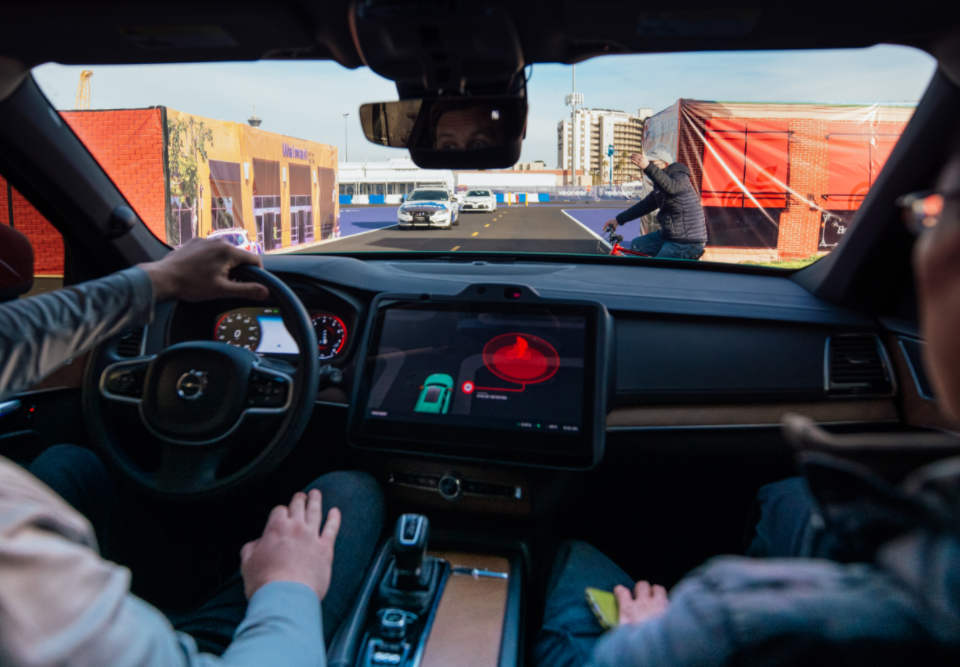
Smart and integrated transportation systems that work perfectly in every instance are just very difficult to realize. Much like humans, vehicles will need to be more flexible depending on the situations they are in. Hence, an outlook for the realisation of AD and fully autonomous cars relies on two major enablers:
The two enablers are united in Veoneer’s Collective Perception Solution, with which the company is able to directly address the latter, but is reliant on the remaining entities in the traffic ecosystem to address the former. Mutual for these enablers is the criticality of real-time communication, which requires investments in wireless connectivity and uniform standards for vehicles, people and traffic environments to become part of that communication.
“This communication link is the major issue right now and we are really struggling to find a good solution. …the final success is completely reliant on the fact that we can communicate.”
Olof Eriksson, Research Specialist at Veoneer
At the moment no available solutions are able to efficiently and safely facilitate the needed communication. As illustrated by ‘Enabling technologies for Veoneer’s collective Perception Solution’ (Illustration 3), communication of AD systems relies on huge amounts of data to be transferred between and processed by multiple entities. For this communication to be efficient and safe, each entity must be guaranteed that it can send and receive the necessary amount of data within a limited timeframe. To achieve this, further progress is needed to align the major discrepancy between available AD technologies and the readiness of the market in terms of insufficient network infrastructure. The progress relies on the actions of two key actors:
Hence, optimally, network producers should deliver the technical functionality for communication, and network operators should be able to implement it. Fortunately, interest is being shown by these actors who are motivated to take action, and academia is actively studying how such actions may take form, not just for the sake of automotive automation, but for all outlooks of digitalisation.
Veoneer believes that a step-by-step approach to AD is the way to increase traffic safety, convenience and less environmental impact during the vehicular life-cycle. With the Collective Perception Solution, the company does not strive to provide a solution that fits the readiness of the market but to provide a solution that accelerates that readiness. Essentially, the aim of the solution is to facilitate autonomous vehicles and AD to achieve the greatest possible benefits for the largest number of drivers, passengers and pedestrians as soon as possible.
“It will for sure be reality. We need to make sure that it is safe to do it. That is the only thing.”
Olof Eriksson, Research Specialist at Veoneer
Vehicular collective perception is a contribution to the global ambition for future mobility to become more intelligent, safe and sustainable. The solution proposed by Veoneer leverages IoT to enable AD systems in delivering improved road safety, transportation convenience and low environmental impact driving.
Collective perception provides a vehicle with the capability to interact and integrate with the ambient infrastructural environment, and with that, it increases the field of view and sensibility of the human driver. This capability enables automated vehicular situational adaptation, which is far more significant than any single safety application, as it allows the vehicle to adjust to challenges detected by the sensors, the integrated control systems and the driver, and as it uses connectivity technology not just to share and process information but to engage and interact with its recipients. Collective perception thereby empowers vehicles, drivers and overall traffic, making our roads safer for all.
“So if we have very good precise information about where everybody is – other cars, pedestrians, bicyclists – we could make it much easier and safer to travel through cities and anywhere actually.”
Olof Eriksson, Research Specialist at Veoneer
The collective perception solution generates internal value for Veoneer as well and offers additional revenue streams through data leverage and AI. The access to new data and distributed processing enables the company to gain insights that are useful for developing the software and adding new features, functionalities and autonomous actuation applications. Such developments can be added up-front to raise the value of a vehicle, via regular updates to institute client relationships through the entire vehicle lifespan, or even on-demand for a continuous profit mechanism. Hence, vehicular collective perception offers significant value both for the user of the vehicle and for Veoneer as a monetisation model with favourable scalability prospects.
“We already have a lot of AI machine learning within our current products, but it will be very different when you bring it up to the scale that we are talking about right now.”
Olof Eriksson, Research Specialist at Veoneer
The outcome of Veoneer’s solution for the customers, i.e. the vehicle manufacturers, is the ability to deliver better driving experiences through more intelligent and autonomous vehicles. The adoption of safety technologies is a key area of focus for OEMs, challenging them to not only develop deeper connections between real-life data and understanding the users, but also to innovate approaches to make the vehicles more available, trustworthy and easy to use. Veoneer cooperates closely with customers during design, development and integration to deliver the technology systems that facilitate the collective perception needed to automate driving for amplified human safety. The current systems represent a relatively standardised technology architecture that can easily be transferred from one vehicle to another and includes, for example:
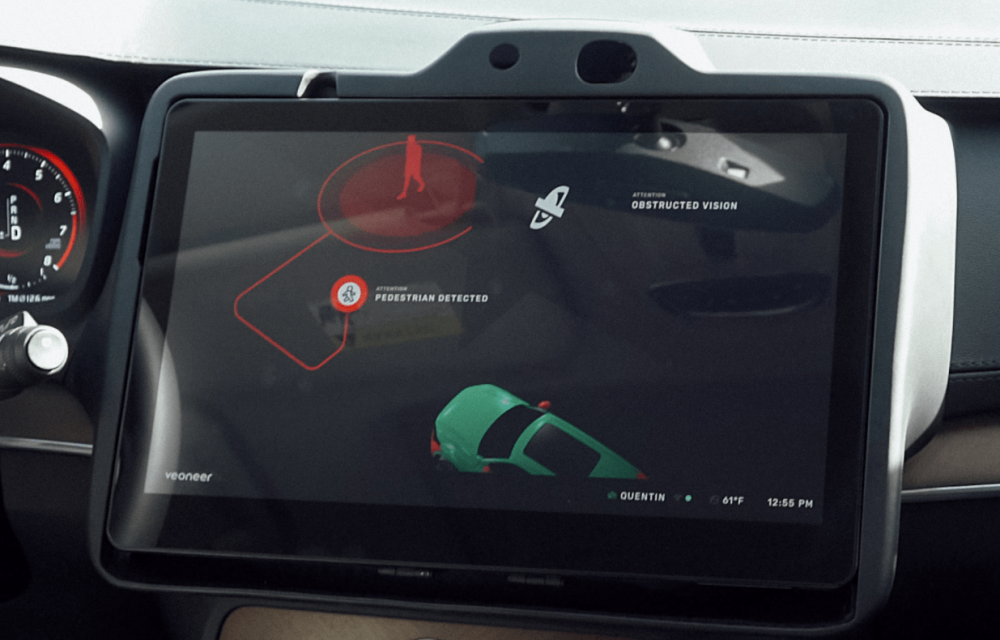
The outcome of Veoneer’s solution for the end-user, the human driver, is full or partial automation of the driving experience. This experience translates into a value proposition in terms of:
The outcome of Veoneer’s Collective Perception Solution is a transformation of not only the driving experience for individual users but the entire traffic ecosystem, as well as it holds the potential to facilitate the shift towards a future of intelligent and sustainable mobility.
“This solution will not only be used for our applications; the automotive safety applications. All the information, since it is IoT data, will be useful for a lot of other stakeholders as well.”
Olof Eriksson, Research Specialist at Veoneer
The central storage of data in the cloud entails multi-actor accessibility to information on the traffic ecosystem. Data is the new gold and a valuable asset also for actors that are not direct participators of the traffic ecosystem; for example, city governments that could find it useful for planning traffic, or ambulance services that could find it useful for accident identification and route optimisation. Hence, the direct outcome of Veoneer’s Collective Perception Solution is democratisation of communication in the traffic ecosystem through a scalable platform for connectivity and interaction where the same base technology standard can be used across entities and locations. Although the market may not be ready for Veoneer’s solution yet, technology in the AD area is constantly advancing and progressing. This is a derived effect of an increasing demand from human drivers, the automotive sector and city governments, as well as research and development efforts feeding the development. These advancements are what will drive the successful implementation of vehicular collective perception and adoption of autonomous vehicles in the future.
“In the end, this solution will give full autonomy.”
Olof Eriksson, Research Specialist at Veoneer
Since the foundation of Veoneer, academic knowledge and technological abilities in the AD area have been increasing, and the prospects for autonomous vehicles and intelligent mobility in the future are revived. Many iterations have passed since the initial idea of a solution for collective perception, and the company has had many learnings along the way. Some of these learnings may have transmissible value for other actors in the IoT ecosystem.
Collective perception is based on the ability of entities in the traffic ecosystem to efficiently and securely communicate. Despite the progress made in the AD area, there is still a great number of challenges and scenarios to be solved. Further progress relies on the market to understand the value to be gained from collective perception.
“The main issue is actually distributing the results. Making people understand why this is good. … Making them understand why we are doing this is a major thing.”
Olof Eriksson, Research Specialist at Veoneer
Although it can be challenging to explain the value outcome of collective perception, due to the solution being at the pilot level, Veoneer is confident that any progress is one step further toward an intelligent traffic ecosystem. The company finds purpose in being one of the actors at the forefront driving this progress.
Veoneer considers a number of points to be vital for the forthcoming success of the Collective Perception Solution. Taking departure in the current state of research and development, these points are compiled into a list of recommendations below:
1. Create a business case for your technology
“It has to be a business case. I am an engineer originally and of course we only like technology, that is the only thing we care about. But it will never succeed unless we have a business case.”
Olof Eriksson, Research Specialist at Veoneer
Make sure not to neglect the importance of responding to actual needs. Veoneer recommends IoT innovators to reflect on the use case, and even more important, the business case for one’s technology. This includes being able to explain how the benefits of your technology overweigh its costs, and why anyone would want to deploy it. If the business case covers a gap in the market, it provides the foundation for prosperous commercialisation and sales of any IoT solution.
2. Collect input from market actors
“Talking to other people, communication between people, that is the only way! …we are collecting ideas from many different sources and try to combine these into a useful system.”
Olof Eriksson, Research Specialist at Veoneer
Veoneer actively seeks to collect input from various actors in and outside the automotive area, in business and in academia, to detect the information needed to develop solutions that break down barriers of the industry to transform towards the future. IoT innovators must prioritise talking to many different people to get an understanding of the needs, desires and problems encountered by the actors in the market – and the potential solutions. One cannot assess and analyse this information alone.
3. Do not neglect monetary value
Value may be defined in numerous ways. It is for sure that Veoneer generates societal value as they unfold their mission of saving lives through their technology systems and applications for automotive safety. When operationalising the mission, the Veoneer team breeds a motivational culture that creates also individual value sentiment. However, to achieve success, the company urges IoT innovators to be well aware that monetary value must be generated on top of all other value aspects.
“It is not going to fly in the end unless you are sure you can make money by doing it.”
Olof Eriksson, Research Specialist at Veoneer
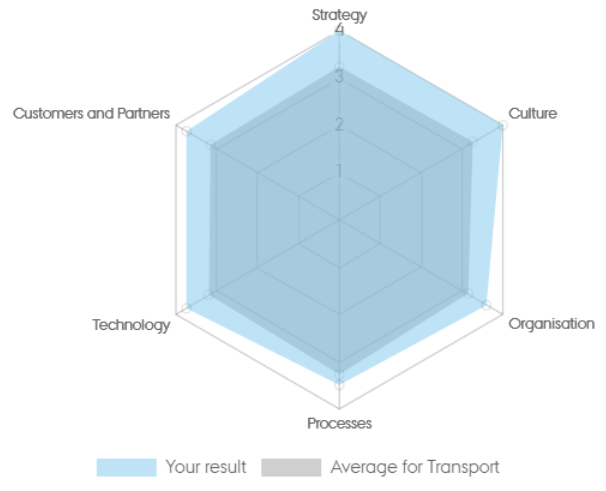
Veoneer assumes a high level of digital maturity with an overall score of 3.77. The score indicates that the digital capabilities of the company are vastly mature, and that they perform above average for the transport sector.
The Digital Maturity Assessment Tool is copyrighted by Associate Professor and PhD Annabeth Aagaard, Director at the Interdisciplinary Centre for Digital Business Development, Aarhus University. To get the digital maturity of your company mapped out, click here.
[1] V2X (Vehicle to Everything): vehicular communication system that facilitates transfer of information between a vehicle and the ambient traffic system that may affect the vehicle. Main components of V2X include vehicle-to-vehicle, vehicle-to-infrastructure, vehicle-to-network and vehicle-to-pedestrian communication.
[2] Levels of Automation (LoA) defined by the Society of Automotive Engineers taxonomy.
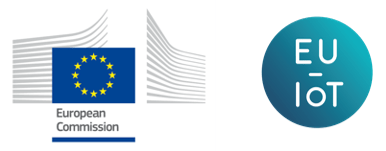
Copyright notice: © 2020 – 2023 EU-IoT Consortium.
This material was produced as part of the EU-IoT project, grant ID 956671, and is funded by the Horizon 2020 Framework Programme under topic ID ICT-56-2020.
EU-IoT is the European IoT Hub. The EU-IoT project works towards growing a sustainable and comprehensive ecosystem for Next Generation Internet of Things.
Source of origin: Information to document this use case originates from the H2020 call: ICT-56-2020 Next Generation Internet of Things (RIA); Project VEDLIoT 957197; Period: 01-11-2020 to 31-10-2023; EC contribution 8 mil. EUR.
